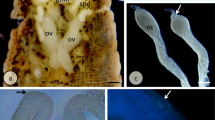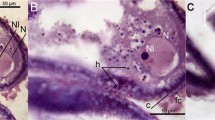Abstract
The aim of this study was to investigate the histological development of right and left ovaries in ostrich embryo. The research was carried out on the ovaries of 20-, 26-, 30-, and36-day-old embryos. At first, anatomical observation was done, and then 5 μm sections of ovaries were stained by hematoxylin and eosin, periodic acid Schiff, and Masson’s trichrome staining methods. Some ovaries embedded in Epon and 1 μm thickness sections were stained with toluidine blue and examined using regular optical microscopy. The results showed ovaries had an unequal growth resulting into a larger left ovary with obvious cortex and medulla. Cortex consisted of germinal cells and germinal epithelium along with somatic cells. At 26 days, the left ovarian cortex was developed with increasing the size of secondary sex cords and numerous germ cells. At more advanced stages of development, germ cells grew in size and contained more granules in the cytoplasm. In the right ovary cortex, there was none visible, and germinal epithelium had a thin layer. Lacunar channels, blood vessels, and interstitial cells along with germ cells were present in the medulla of both ovaries. The medullary germ cells were observed as solitary cells or group of several cells. In general, we demonstrate the histological changes in the left and right ovaries of ostrich from 20- to 36-day-old embryos. In addition, this work is the first study that provides histological evidence for the normal structure of ovaries and suggests the time of onset of meiosis in the ostrich embryo






Similar content being viewed by others
References
Armengol C, Carretero A et al (2007) Carbohydrate characterization of quail primordial germ cells during migration and gonadal differentiation. J Anat 210(1):98–111
Ayers KL, Sinclair AH et al (2013) The molecular genetics of ovarian differentiation in the avian model. Sex Dev 7(1–3):80–94
Bannister SC, Tizard ML et al (2009) Sexually dimorphic microRNA expression during chicken embryonic gonadal development. Biol Reprod 81(1):165–176
Bronneberg RG, Taverne MA (2003) Ultrasonography of the female reproductive organs in farmed ostriches (Struthio camelus spp.). Theriogenology 60(4):617–633
Carre GA, Couty I et al (2011) Gene expression profiling reveals new potential players of gonad differentiation in the chicken embryo. PLoS One 6(9):e23959
Chue J, Smith CA (2011) Sex determination and sexual differentiation in the avian model. FEBS J 278(7):1027–1034
Gefen E (2001) Morphological description of the developing ostrich embryo: a tool for embryonic age estimation. Isr J Zool 47:87–97
Gonzalez-Moran MG (2011) Histological and stereological changes in growing and regressing chicken ovaries during development. Anat Rec 294(5):893–904
Guioli S, Lovell-Badge R (2007) PITX2 controls asymmetric gonadal development in both sexes of the chick and can rescue the degeneration of the right ovary. Development 134(23):4199–4208
Ishimaru Y, Komatsu T et al (2008) Mechanism of asymmetric ovarian development in chick embryos. Development 135(4):677–685
Jung JG, Kim DK et al (2005) Development of novel markers for the characterization of chicken primordial germ cells. Stem Cells 23(5):689–698
Madekurozwa MC, Kimaro WH (2006a) A morphological and immunohistochemical study of healthy and atretic follicles in the ovary of the sexually immature ostrich (Struthio camelus). Anat Histol Embryol 35(4):253–258
Madekurozwa MC, Kimaro WH (2006b) Ultrastructural features of the follicular wall in developing follicles of the sexually immature ostrich (Struthio camelus). Onderstepoort J Vet Res 73(3):199–205
Mork L, Tang H et al (2012) Mouse germ cell clusters form by aggregation as well as clonal divisions. Mech Dev 128(11–12):591–596
Nakamura Y, Kagami H et al (2013) Development, differentiation and manipulation of chicken germ cells. Dev Growth Differ 55(1):20–40
Park TS, Han JY (2000) Derivation and characterization of pluripotent embryonic germ cells in chicken. Mol Reprod Dev 56(4):475–482
Pepling ME, Spradling AC (1998) Female mouse germ cells form synchronously dividing cysts. Development 125(17):3323–3328
Smith CA, Andrews JE et al (1997) Gonadal sex differentiation in chicken embryos: expression of estrogen receptor and aromatase genes. J Steroid Biochem Mol Biol 60(5–6):295–302
Smith CA, Roeszler KN et al (2008) Onset of meiosis in the chicken embryo; evidence of a role for retinoic acid. BMC Dev Biol 8:85
Suárez-Bonnet A et al (2012) Follicular ovarian torsion in an ostrich (Struthio camelus). Vet Q 32(2):103–105
Swartz WJ (1982) Acid and alkaline phosphatase activity in migrating primordial germ cells of the early chick embryo. Anat Rec 202(3):379–385
Ukeshima A (1994) Abandonment of germ cells in the embryonic chick ovary: TEM and SEM studies. Anat Rec 240(2):261–266
Ukeshima A, Fujimoto T (1991) A fine morphological study of germ cells in asymmetrically developing right and left ovaries of the chick. Anat Rec 230(3):378–386
Voronina E, Seydoux G et al (2011) RNA granules in germ cells. Cold Spring Harb Perspect Biol 3(12)
Wang Y, Peng KM et al (2008) Ultrastructure and melatonin 1a receptor distribution in the ovaries of African ostrich chicks. Cytotechnology 56(3):187–195
Yoshinaga K, Fujimoto T et al (1992) Selective lectin-binding sites of primordial germ cells in chick and quail embryos. Anat Rec 233(4):625–632
Yoshinaga K, Nakamura M et al (1993) Ultrastructural characteristics of primordial germ cells in the quail embryo. Anat Rec 236(3):547–552
Acknowledgments
This research was supported by a grant (no. 22934) from the Research Council of the Ferdowsi University of Mashhad. None of the authors of this paper has a financial or personal relationship with other people or organizations that could inappropriately influence or bias the content of the paper.
Author information
Authors and Affiliations
Corresponding author
Rights and permissions
About this article
Cite this article
kheirabadi, M., Nabipour, A., Behnam Rassouli, M. et al. Morphological development of ovaries in ostrich (Struthio camelus) embryo. Comp Clin Pathol 24, 1185–1191 (2015). https://doi.org/10.1007/s00580-014-2058-8
Received:
Accepted:
Published:
Issue Date:
DOI: https://doi.org/10.1007/s00580-014-2058-8




